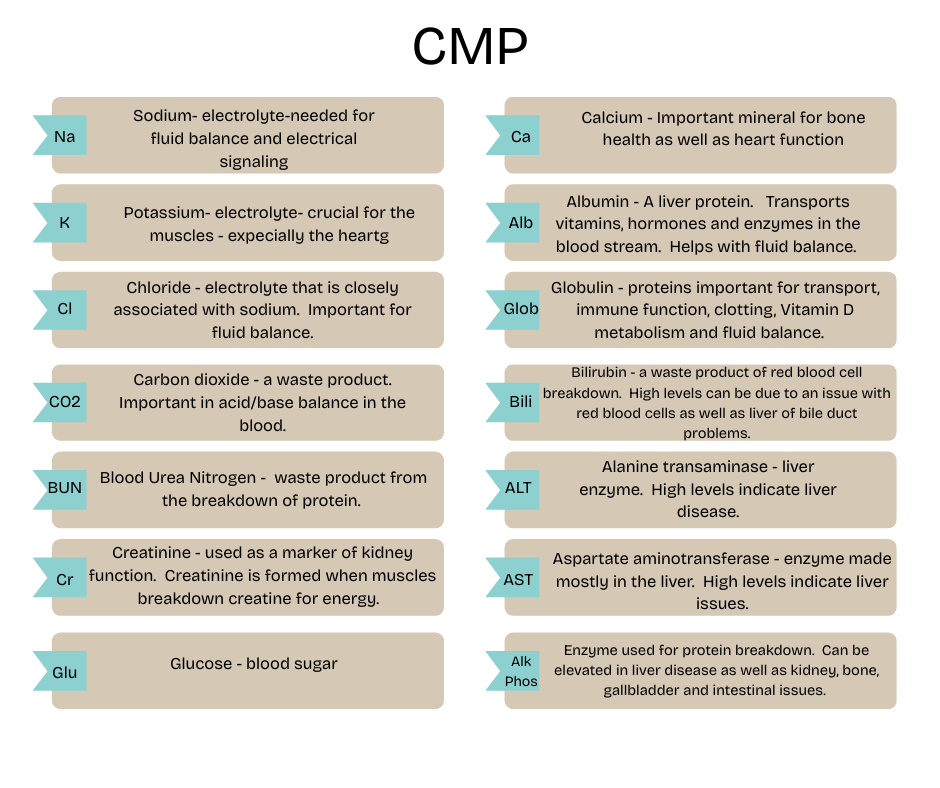Metabolic Measurement Packages
(available for both members and non-members)
Basic metabolic labs and measurements
The Basic Metabolic Lab Package gives you a powerful snapshot of how your body is functioning on the inside. It includes a Comprehensive Metabolic Panel (CMP) to assess kidney and liver function, electrolytes, and blood sugar; a cholesterol panel to evaluate your lipid balance; and key markers like A1c and insulin to identify early signs of insulin resistance. It also measures vitamin D, an essential hormone for immune and metabolic health, and hs-CRP, a sensitive marker of inflammation that can signal increased risk for heart disease. Together, these labs help uncover the root causes of fatigue, weight changes, or inflammation - giving you the information you need to optimize your health before problems progress.
-
Blood Pressure
Heart Rate
Waist to Height Ratio
Weight
-
CMP
Lipid Panel
A1c
Fasting Insulin
Vitamin D
hs-CRP
*average cash pay cost of these labs elsewhere is $240
Comprehensive metabolic labs and measurements
The Comprehensive Metabolic Lab Package offers a deep look into how your body is truly functioning - far beyond a basic checkup. It includes a Comprehensive Metabolic Panel (CMP) to assess liver, kidney, and electrolyte balance, a CBC to evaluate blood cell health, and key metabolic markers like A1c and insulin to detect early signs of insulin resistance. hs-CRP measures inflammation, while magnesium and phosphorus reflect cellular energy and muscle function. Vitamin D supports immune and metabolic balance, and hormone testing for testosterone and DHEA-S reveals how stress, aging, or lifestyle may be affecting vitality. Finally, a full thyroid panel helps identify imbalances that can impact energy, weight, and mood. Together, these labs provide a detailed picture of your metabolic and hormonal health so you can take proactive steps toward optimal wellness.
-
Blood Pressure
Heart Rate
Waist to Height Ratio
Weight
-
CMP
CBC with diff
Lipid Panel
A1c
Fasting Insulin
hs-CRP
Thyroid Panel: TSH, FT3, FT4
DHEA-S
Testosterone: free and total
Magnesium
Phosphorous
*average cash pay cost of these labs elsewhere is $550
Learn more about your labs:
Comprehensive Metabolic Panel (CMP)
The CMP looks at your electrolytes, kidney function and liver function.
The ALT and AST are the liver markers on this panel. According to the lab's reference range - normal is 0-40 for the AST and 0-44 for the ALT. If you doctor is just using the lab reference range to determine if your labs are 'normal' then he or she may be missing the early signs of fatty liver disease. This is a growing problem and one that when caught early can be treated effectively with dietary changes. Optimal ALT and AST are mid 20's and under.
Complete Blood Count with Differential (CBC with diff)
This is a test that looks at your red blood cells, white blood cells and platelets. These can be out of range with anemia, infections, allergies and even cancers. The lab reference ranges are correct on the CBC.
Lipid Panel
The lipid panel evaluates your cholesterol, the lipoprotein particles that transport cholesterol around the body (LDL and HDL), and your triglycerides.
Hemoglobin A1c (HbA1c)
This is the marker that we use to estimate your average blood glucose level over the past 3 months. Red blood cells live approximately 120 days (give or take). While these red blood cells float around in your blood they become tagged (glycated) by sugar. The more sugar in the blood - the higher the A1c. There are some conditions that cause the red blood cells to have a shorter lifespan - in these cases the A1c may be lower than the actual average glucose levels in the blood. For example, someone with hemolytic anemia. On the other hand, someone with iron deficiency anemia may actually have a slightly higher A1c than their actual average blood glucose levels. Optimal Level: 4.5-5.4
High Sensitivity C Reactive Protein (hsCRP)
This is a marker of inflammation in the body. When it is elevated it can help to predict your risk of heart disease. A caveat to know - this is still a generalized marker of inflammation - it can be elevated for other reasons such as infection or an autoimmune condition. Optimal level: 0-1.0
Magnesium
A mineral in the blood involved in numerous processes in the body such as: maintaining your normal heart rhythm, muscle and nerve function, bone health, regulating blood sugar and blood pressure, and more. While there is a reference level on the labs which deviations from would indicate big issues, the symptoms you are having are often used to determine if your levels are optimal. (for example - although blood tests may indicate a normal magnesium level - you may be experiencing leg cramping which could benefit by supplementation). Optimal level: 1.60-2.3
Phosphorous
A mineral in the blood that is involved in bone health as well as nerve function. Optimal level: 2.5-4.5
Vitamin D
Has many functions in the body. It is important for bone health, calcium and phosphorous regulation, immune function as well as mood stabilization. There are a number of different tests for Vitamin D. The best one to have checked is Vitamin D 25. Optimal level: 50-100
Dehydroepiandrosterone Sulfate (DHEA-S)
This is a precursor to your sex hormones. It is produced by the adrenal glands and is a good indicator of your adrenal function. Optimal level (male) 300-600. Optimal level (female) 65-380
Fasting Insulin
This is a very important marker of metabolic health. You need baseline amounts of insulin in order for your cells to take in glucose and for the body to store energy. High levels of insulin indicates hyperinsulinemia and often metabolic syndrome. This marker is elevated long before your A1c becomes elevated. If you address this early, you may be able to avoid ever developing diabetes. Optimal Level: 2.0-5.0
Thyroid Panel:
Thyroid Stimulating Hormone: this is produced by the pituitary gland in the brain. It senses the level of T4 (the primary thyroid hormone) and communicates with your thyroid gland whether it needs to make more. When your thyroid is not functioning appropriately and not making enough T4, the TSH level will be elevated. If the thyroid gland is producing too much T4, the TSH will be very low. Optimal level: 0.5-2.0
Free T4 - the primary thyroid hormone. It is made from 4 atoms of iodine. It is actually largely inactive and must be converted to T3 to be used by the body. There is both a free version (Free T4) and a bound version. The bound version is attached to carrier proteins to transport it around the body - it is not available for use until it is in the free form. Optimal level: 1.0-1.5
Free T3 - the active thyroid hormone. It is made from 3 atoms of iodine. Optimal level: 3.0-3.5
Testosterone - Free and Total
Testosterone plays a major role in energy, muscle strength, motivation, mood, and even metabolism. When we check testosterone, we look at total (the overall amount your body makes) and free (the portion your body can actually use). Sometimes total testosterone looks “normal,” but free testosterone is low - meaning your body isn’t getting the benefit. Understanding both helps uncover hidden causes of fatigue, low libido, and slow progress with weight loss or muscle tone. Checking your levels gives valuable insight into how well your body is supporting your metabolism and overall vitality. Optimal levels: Total 500-1100 Free 9.3-26.5
metabolic measurements
Your metabolic health is about far more than just your weight. It includes balanced blood sugar, a healthy cholesterol profile, normal blood pressure, and a good body composition.
We measure your height, weight, waist-to-height ratio, blood pressure and heart rate.
You may wonder why we measure waist-to-height ratio instead of BMI. The reason is that when the liver starts accumulating fat (a condition known as fatty liver), it tries to export that fat into the bloodstream - leading to abdominal or visceral fat.
This visceral fat, which surrounds your internal organs, is much more dangerous than the fat just under your skin (the pinchable, subcutaneous kind - yes, even the cellulite we all dislike). Visceral fat drives chronic inflammation and increases your risk of heart disease, stroke, and diabetes.
BMI can be misleading. You might have a “normal” BMI but still carry excess visceral fat - what we call TOFI (“Thin on the Outside, Fat on the Inside”). Or you may have a higher BMI but healthy internal fat levels.
That’s why measuring your waist-to-height ratio gives us a clearer picture of your true metabolic health.






